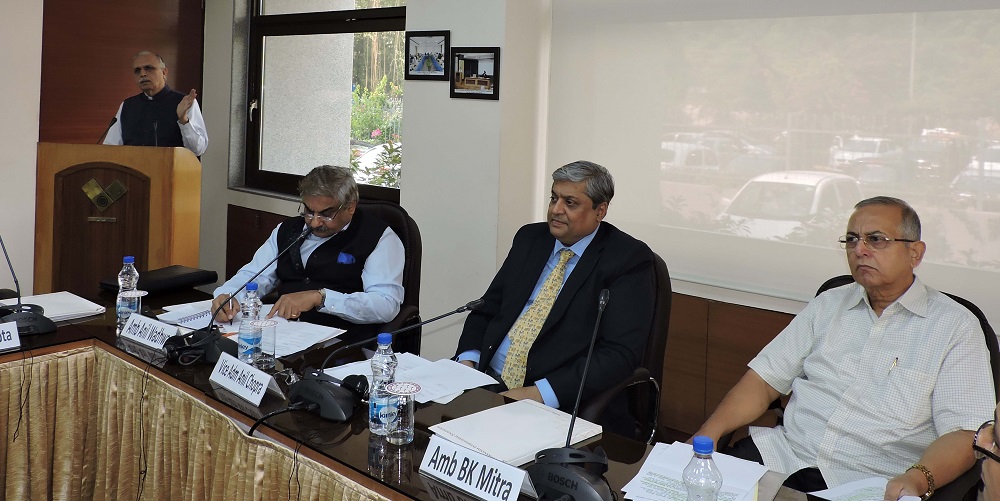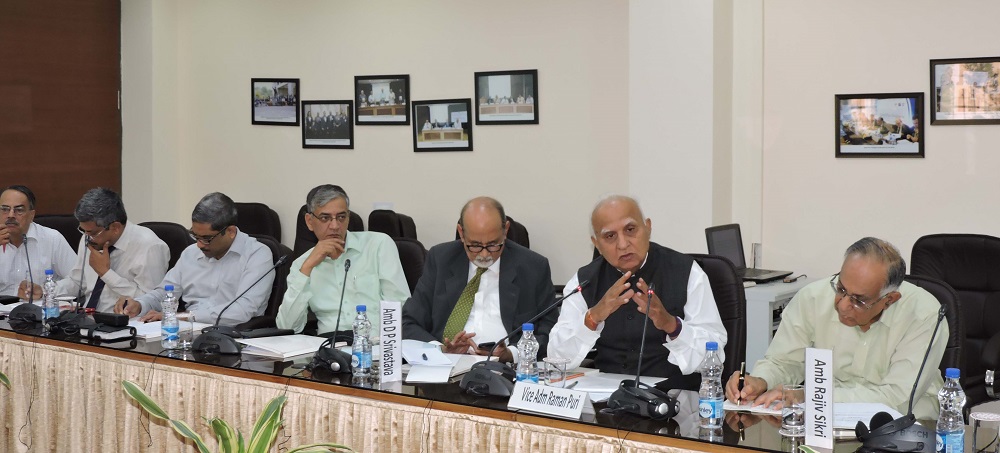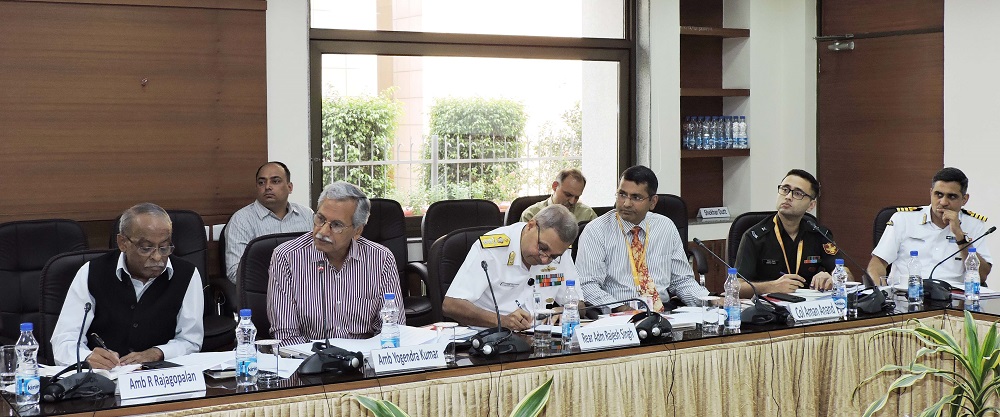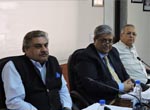Keeping Conflicts at Bay - Need for Bay of Bengal Community
In today’s geopolitical landscape, regions are the locus of competition, conflict and cooperation. The Indian Ocean Region (IOR) is too diverse and large to always comprehend holistically. Therefore, the Vivekananda International Foundation (VIF) decided to break
it down into smaller sub-regions that share similar challenges and aspirations. Accordingly a Round Table Discussions (RTD) was conducted on the Bay of Bengal (BoB) on October 26 with eminent scholars and practitioners. The panel was moderated by Vice Adm Anil Chopra and comprised Dr Vijay Sakhuja, Amb Anil Wadhwa, Amb BK Mitra and Prof Shankari Sundararaman, in addition to other eminent invitees. The Director, Dr Arvind Gupta, commenced the session with his opening remarks on the historical perspective and the current significance of the region. This was followed by a presentation on the BoB by Commodore Somen Banerjee, Senior Fellow VIF, on macro issues of economy, conflicts, major ports, intra-regional trade, infrastructure developments, connectivity and significance of the Andaman and Nicobar islands, which set the stage for further discussions.

Lines of Discussion
If we step back and take a look at the Indo-Pacific as a whole, the BoB is right at the middle. As the Western adjunct of the South China Sea, the waters of the BoB connect the Indian and Pacific Oceans. It also lies in the midst of regional structures such as the Association of Southeast Asian Nations (ASEAN), the Bay of Bengal Initiative for Multi-Sectoral Technical and Economic Cooperation (BIMSTEC) and the South Asian Association for Regional Cooperation (SAARC). The BoB influences China’s southern landlocked region and is at the heart of economic emergence of its riparian and landlocked countries of the Indo-Asia-Pacific. The idea of the BoB as a multilateral, strategic and economic community has thus engendered multiple interests and narratives.
Historical Perspective
Until the Bay of Bengal was reduced to a strategic backwater by the British Raj in the early decades of the 19th century, it was the site for major geopolitical contentions among the Asian and European powers. The raids of SMS Emden of the Imperial German Navy and the ensuing naval battles during World War I highlight the strategic significance of the BoB. Once again, during World War II, when Japan overthrew the British and European primacy, the BoB emerged as a sea of churn. It took the might of the British Raj, the Commonwealth, China and the United States (US) to restore peace in the region. This reaffirms the allure and vulnerability of the region from external influences. BoB was divided horizontally during the colonial era between the British and the Dutch. Post WW II, it got divided vertically between South Asia and South East Asia. BoB started to resume its shape as a singular entity quite recently, after the states were able to set their gaze outward, post internal consolidations.

China: an Outsider with Growing Interests in the Bay
In early April this year, a 2200 kilometer gas - oil pipeline was operationalized from the deep water port at Kyaukphyu in Myanmar to Nanning/ Kunming. The project was officially begun in 2007 well before the strategic concept of One Belt One Road (OBOR) had matured. Commencing 2013, China has invested billions of dollars in infrastructure projects under the aegis of OBOR. Some of these projects, like the Myitsone dam, have suffered setbacks due to local distrust against the Chinese. A slew of collaborative projects have also been announced in Bangladesh including a Memorandum of Understanding (MoU) on the 9th Friendship Bridge signed on 11 May 17. Seven bridges have already been completed by China and construction of the eighth is underway. China has also assisted Bangladesh with $157 million grants and loans for setting up vital economic, networking and technical cooperation projects. Thailand's government too had recently approved US $5.2 billion to build the first stretch of a high-speed railway that will ultimately link Bangkok to southern China. Despite oppositions and delays China has been persistently trying to make inroads into the region and fill the current strategic vacuum. However, peace and stability of BoB and economic development is important for all nation states of the region. Therefore, India would need to build capacity and architectures with the resident countries and balance the growing influence of China, an outsider in the BoB.
Internecine Conflicts
Both, the Islamic State (IS) and Al Qaeda (AQ) are competing to strike attractive targets in the region. As IS is losing territories in its heartland in Iraq and Syria, it is trying to expand horizontally by establishing new wilayats in the region. Most notable attack by the IS has been on Holey Artisan Café in Jul 16 in the capital city Dhaka. Additionally, Bangladesh is facing a growing threat from Al Qaeda that was responsible for targeting bloggers and activists. With Inter-Services Intelligence (ISI) assistance, Al Qaeda is believed to have provided training and support to the Rohingya militants and maintained ties with Rohingya Solidarity Organisation (RSO). A significant faction of RSO has close operational ties with fundamentalist extremist like Laskar-e Taiba in Pakistan, Indian Mujahideen and Jama‘at-ul Mujahideen Bangladesh (JMB). Growing militancy in Myanmar has resulted in military crackdown on the Rohingyas, which has led to large scale migration. Terror threats have persisted in Indonesia, Malaysia and Thailand too. A festering Rohingya crisis coupled with deep seated tensions between intra-state communities in the region creates opportunities for exploitation by regional and international terror groups like IS, AQ and JMB, and puts the peace and stability of the region at risk. Countering these threats will require concerted efforts at the bilateral and multilateral levels for intelligence, surveillance and reconnaissance (ISR), training and operational synergy between the security agencies.

Bay of Bengal Community
In addition to Islamic terrorism, other non-traditional threats such as piracy, illicit trade, trafficking, Illegal Unreported Unrestricted (IUU) fishing, earthquakes, cyclones, and tsunami also need coordinated action and contingency planning. Here regional countries look up to India for leadership and to assume a role of net security provider. To begin, India would need to enhance dialogue around issues of common interest, such as Humanitarian Assistance and Disaster Relief (HA/DR), illicit trafficking etc. Partners need to be offered capacity building assistance that they can absorb. The Navy and Coast Guard would require to take the lead in these aspects and set up regional Information Sharing Centers (ISCs) in line with the East African countries or the Information Fusion Center (IFC) at Singapore. Setting up an ISC/ IFC for BoB at Port Blair Joint Command is urgently required to be established. However, prior to execution, Ministry of External Affairs (MEA) would have to take all states in the BoB onboard and states have to be convinced that benefits accrued from this initiative would be more than the costs. Regular exercises would not only help build capacities and peacetime interoperability but also enhance readiness for conflicts. The security architecture could be extended to other facets of cooperation as well. In this respect the India-Bangladesh-Myanmar (IBM) Forum for Regional Cooperation (FRC) complements Bangladesh, Bhutan, India, Nepal Group (BBIN) and the ‘Bay of Bengal Initiative for Multi-Sectoral Technical and Economic Co-operation’ (BIMSTEC). BIMSTEC could be further strengthened to address the security issues of BoB Community. The recommendations of the First Annual Meeting of the National Security Chiefs of BIMSTEC in New Delhi on March 21 requires to be implemented to counter terrorism, violent extremism and radicalization; and deepen cooperation to deal with traditional and non-traditional security threats in a comprehensive manner.
Infrastructure and Connectivity
India’s response to China’s infrastructure projects should be both bilateral and multilateral. On most occasions Indian infrastructure projects abroad have ended up in cost and time overrun. India’s inability in effectively implementing projects agreed to in various bilateral and multilateral agreements erodes her credibility and need to be overcome. It would therefore, be prudent to institute an Infrastructure Commission to steer all foreign projects of India that will coordinate all the ministries and agencies in the country. A study need to be undertaken to understand the nature of the current limitations in project execution and recommend the scope and structure of such a commission. Further, the port developments being sponsored by India in the BoB could be made an external extension of the Sagarmala project. Only 1.8 percent of the Indian trade is currently being carried on Indian shipping. Ministry of Shipping would have to study the feasibility of increasing the volume of Indian bottomed shipping progressively.

Significance of Andaman and Nicobar Islands
Andaman & Nicobar (A&N) Islands are the geopolitical sentinel of the BoB. It sits astride one of the busiest sea lanes of the world. Most of the merchant traffic passing between the Indian Ocean and the Pacific pass through the Malacca Straits and the Six Degree Channel, which is close to the Nicobar Islands. The A&N islands are also susceptible to illegal immigration from conflict ridden countries across the Andaman Sea. Despite their strategic location, these islands are vulnerable to both traditional and non-traditional threats. This could be attributed to lack of requisite infrastructure and organic facilities to support large military formations. Consequently, A&N is to be developed as Forward Operation Bases (FOBs) and not as full-fledged base like Visakhapatnam or other Services Commands. The Command at A&N should be capable of immediate defence of the islands and its Exclusive Economic Zone (EEZ). Additionally, the FOBs should be capable of supporting the surveillance and trans-island movement of troops and equipment and support sea-control and sea-denial missions of the Indian Navy for a limited period. Infrastructure being built by National Highway and Infrastructure Development Corporation Ltd (NHIDCL) and Island Development Authority (IDA) should be for ‘dual use’ to the extent feasible. This will not only be cost effective but also allow sudden surge of military mobilization when required. Coastal surveillance needs to be enhanced by augmenting the marine police. If India has to project power in Indo-Pacific, A&N should be capable of becoming the launching base with the command and control being exercised by the theater command at Visakhapatnam.

Recommendations
In view of the rising importance of the BoB and strategic significance of the A&N Islands, China’s growing influence on land and sea needs to be balanced. Accordingly, recommendations emerging from the RTD are listed in the paragraphs following.
The Indian Navy:
a. Build sub-regional security architecture like the Information Sharing Center (ISC) or Information Fusion Center (IFC) that could be based at Port Blair in line with the East African or Singapore structures.
b. Regular exercises between countries may be conducted to improve interoperability in terms of communication, command & control and Standard Operating Procedures (SOP).
c. A&N is to be developed as FOBs and not as full-fledged base like Visakhapatnam or other Services Commands.
d. FOBs should be capable of supporting the surveillance and trans-island movement of troops and equipment and support sea-control and sea-denial missions of the Indian Navy for a limited period.
Ministry of Shipping: Ministry of Shipping is to study the feasibility of increasing the volume of Indian bottomed shipping progressively.
Ministry of Roads and Highways and A&N Administration:-
a. Port developments being sponsored by India in the BoB could be made an extension of the Sagarmala project.
b. Infrastructure being created by NHIDCL and IDA should be dual-use to the extent feasible.
c. Coastal surveillance needs to be enhanced by augmenting the marine police.
The MEA:-
a. Get the governments of the BoB region on board to set up a regional ISC/IFC by convincing them that the benefits are more than the costs.
b. BIMSTEC could be further strengthened to address the security issues of BoB Community. The status on implementation of the First Annual Meeting of the National Security Chiefs in New Delhi on March 21, may be reviewed at regular intervals.
c. India’s response to China’s infrastructure building should be both bilateral and multilateral.
National Security Council:-
a. A study may be undertaken to understand the nature of the current limitations in project executions abroad.
b. Based on the above study report, set up an Infrastructure Commission to coordinate the foreign infrastructure to reduce cost and time.
c. The recommendations of the First Annual Meeting of the National Security Chiefs of BIMSTEC in New Delhi on March 21 may be implemented to counter terrorism, violent extremism and radicalization; and deepen cooperation to deal with traditional and non-traditional security threats in a comprehensive manner.



